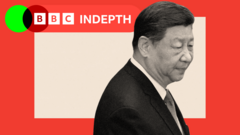China's economy, once perceived as an unstoppable force, is now weathering significant challenges that have less to do with US tariffs and more to do with its internal market struggles. President Xi Jinping, who took office over a decade ago with the promise of a revitalized China, faces mounting pressures from a housing crisis, rising unemployment, and wavering consumer confidence.
In the bustling trade scenes across China, discussions around Donald Trump's import tariffs elicit a blend of laughter and mockery rather than fear. Online nationalists have even transformed these tariff threats into viral memes, poking fun at US leadership while rallying national pride. Xi’s government insists that the country’s economic progress relies on self-sufficiency and innovation rather than concessions to external pressures.
China's lessened dependence on US exports, significantly down from a decade ago, perhaps emboldens the current administration's stance. However, domestic challenges remain dire: millions of homes sit vacant as the property market falters, causing financial distress amongst citizens who have invested all their savings. Analysts predict a continued decline in home values, compounding fears over pension sustainability and job security among the younger population, with youth unemployment officially surpassing 20%.
Despite the pressures emanating from Trump's tariffs, observers believe that the real battleground lies in how China adapts its internal policies. Economic initiatives, including enhanced childcare subsidies and a $41 billion spending drive on consumer goods, reflect attempts to stimulate domestic demand. Yet experts caution against the sustainability of such measures without fundamental shifts in disposable income.
Xi's administration is also aware of the potential for civil unrest, stirred by a disenchanted youth worried about their futures. Although protests related to economic grievances have surged in recent months, quick government censorship suppresses any immediate threats to Xi's leadership.
Amidst this turbulence, China is making strides in advanced manufacturing and technology sectors, striving for a self-sufficient economy capable of global outreach. Meanwhile, trade relationships are shifting, with a growing focus on connecting with Southeast Asia, Latin America, and Africa as alternatives to US markets. This realignment has already begun showing dividends, positioning China favorably in over 145 countries, reflecting a more stable trading partner contra the unpredictability presented by US policies.
Despite past geopolitical tensions, Xi seeks to leverage the situation to reshape China's image as an invulnerable economic powerhouse in the face of external threats. If successful, Xi may turn the current crises into opportunities for greater influence while also addressing internal economic flaws that could undermine his tenure. However, the question remains whether these efforts will be enough to maintain stability in the long term. As the situation develops, all eyes will remain on China's ability to adapt and grow amidst its pressing challenges.




















